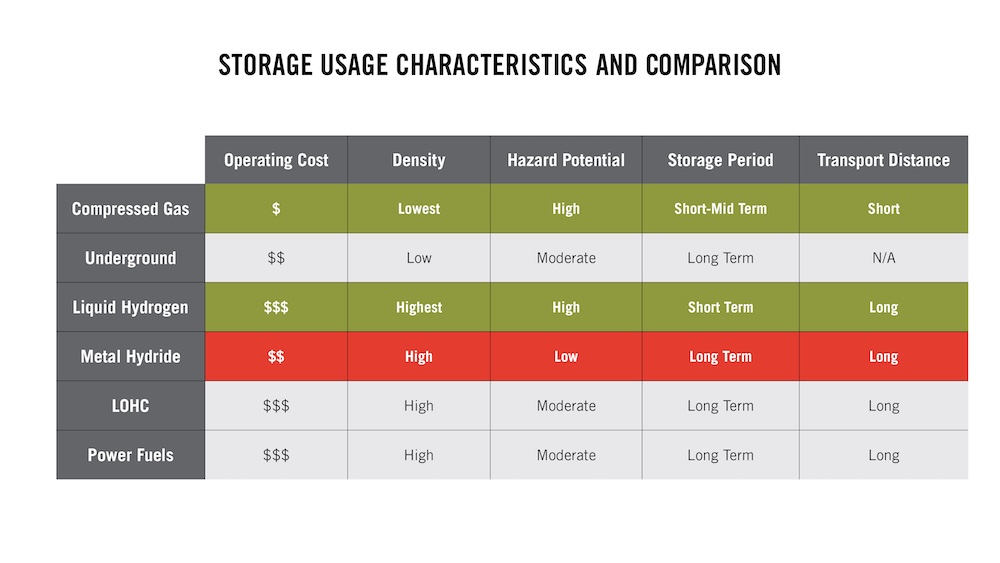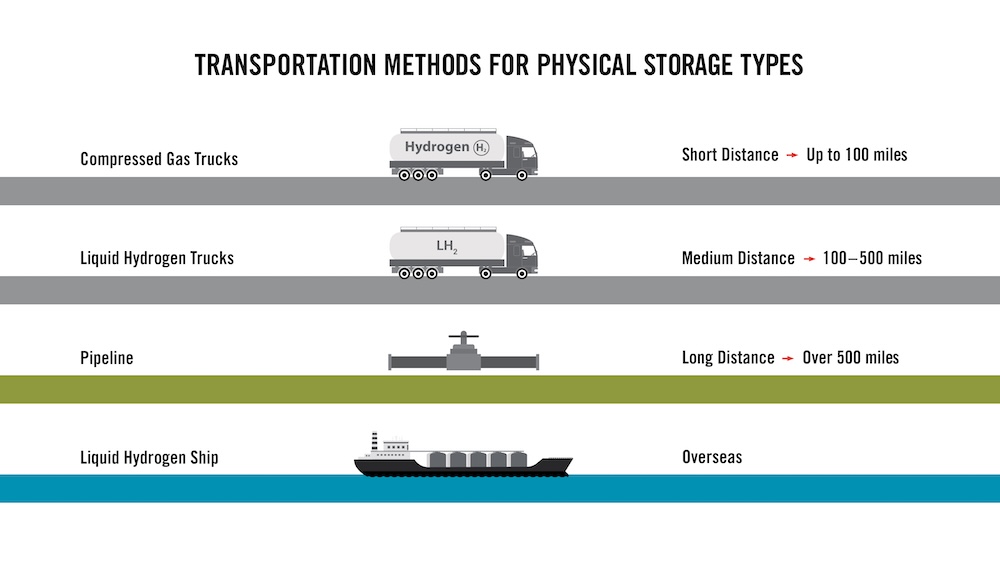Unpacking Storage and Transport Methods for Commercial Hydrogen Production
As the global energy transition marches on, hydrogen remains a promising energy carrier for a decarbonized system. Demand for clean hydrogen is expected to increase two to four times by 2050, facilitating the shift to a carbon neutral grid and cleaner methods of transportation.[1] The viability of commercial hydrogen production systems depends on product gas storage and transport methods, as well as robust transmission and distribution infrastructure. Each method features its own unique challenges to large-scale production, and storage and transport costs vary by method and usage characteristics. Compounded together, these factors are impacting the more widespread implementation of hydrogen production systems.

Hydrogen often travels from its production site to points of end use, and transportation costs vary according to storage method and total distance traveled. Compressed gas trucks (above) carry hydrogen across relatively short distances, while pipelines and liquid hydrogen ships are used for large-scale transport.
Storage is a critical aspect of commercial hydrogen production design, as it provides a buffer capacity between production and loadout. Hydrogen can be stored through physical containment or by chemical carriers, where it is chemically bound to a material and then contained or transported.
Physical hydrogen storage methods
Physical storage is the most mature method and includes use of compressed gas pressure vessels, underground spaces, and liquification. Compressed gas pressure vessels are among the most popular — composed of carbon fiber composite to minimize weight and maximize pressure limits, ranging between 3,000 and 10,000 psi. These vessels are typically used in stationary hydrogen filling stations or for small-scale storage, and are generally the least expensive option. Energy density, however, is relatively low, and because the flammable gas is stored at very high pressures, it poses a significant fire safety hazard.
Underground storage options range from salt caverns and hard rock caverns to depleted oil and gas wells and aquifers. These geological storage sites are better suited to longer periods of storage, as large volumes of hydrogen can remain for several days, weeks, and even months at a time. Salt caverns, in particular, offer a safe storage method that boasts relatively low investment and operations costs. However, these options are limited by geography as they are unevenly distributed throughout the US, often far from production and loadout sites. In addition, they are not conducive to high turnover cycles inherent in surge capacity between production and export productions. Recent salt cavern case studies have storage for 500 tons of hydrogen, which costs about $36/kgH2 to prepare.[2] If it’s stored for four months, the levelized cost would be $1.2/kg, and $0.15/kg if stored for 15 days.[3]
The third physical storage method is liquid hydrogen, which occurs at -235°C (-455°F). While this option yields high hydrogen purity, the liquefaction process is energy intensive and results in higher hydrogen boil-offs. This translates to high energy costs, especially when compared to compressed gas. For example, if hydrogen is stored in a large, highly insulated tank for one week, the levelized cost would be between $0.055 and $0.91/kgH2 with an additional $1.2/kg for liquefaction at a large-scale plant.[4] This method also presents high hazard potential, and the equipment required for liquefaction is specialized and not readily available. However, liquid hydrogen’s energy density is much higher, meaning a given quantity of hydrogen requires smaller or fewer vessels for transport.
Chemical hydrogen storage methods
Alternatively, chemical carrier options include metal hydrides, liquid organic hydrogen carriers (LOHC), and “power fuels” of ammonia and methanol. All chemical carriers have relatively high densities and slow-release rates, making them largely unsuitable for surge storage in production applications. These methods are in the early phases of development, and more research is needed to determine cost and energy efficiency.

Compressed gas and liquid hydrogen (highlighted in green) are the most commonly used storage types, while metal hydrides (highlighted in red) are rarely employed. Compressed gas has high-cost efficiency, and liquid hydrogen offers high energy density. By contrast, metal hydrides have high energy densities and medium operating costs, but more research is needed before we see broader adoption of this method.
Types of hydrogen transport
In addition to storage types and costs, transmission and distribution remain important factors in scaling up commercial hydrogen production. When points of use are relatively close to the production sites, compressed gas via tube trailers are the best choice due to freight cost, which is based on the low energy density of the gas. One tube trailer can transport between 500 and 1,000+ kg of compressed hydrogen in one trip, typically about 100 miles. However, the round trip and fueling time may take a full workday to complete. As the distance increases, liquid hydrogen transport becomes the more viable option. Between roughly 100 and 500 miles, liquid hydrogen trucks require fewer loads to supply the same energy of hydrogen as compressed gas vehicles. This begins to offset the higher energy costs required to produce the liquid form.
For long-distance transport, pipelines offer an energy-effective method. They can distribute hydrogen across approximately 500 miles or more, and have the potential to provide daily storage in addition to transport. Costs depend on pipe length and diameter: recent studies estimate cost to be less than $0.5/kgH2 for large diameter pipes, but over $2/kgH2 for small diameter, long pipelines.[5] The lack of national pipeline networks, however, makes this a long-term goal rather than a current reality. Strengthening pipeline infrastructure would require high capital investment and significant regulatory considerations. At present, the most competitive methods produce large quantities of hydrogen and transport it to other nearby hydrogen users, such as vehicle fueling stations. If hydrogen is transported overseas by ship, it would be in liquid form, either as liquid hydrogen or as a power fuel such as ammonia, to maximize transport energy density.

While compressed gas trucks offer low operating costs, the low energy density makes this gas unsuitable for large-scale transportation. Liquid hydrogen — carried by truck or ship — requires fewer loads to transport the same quantity.
Looking ahead
Hydrogen rightfully remains a topic of conversation within decarbonized energy systems. It has potential to transition the grid and transform carbon-heavy industries like steel production and airline transportation, among others. But the capital costs associated with commercial hydrogen production, coupled with regulatory uncertainties, cannot be discounted in system design.
Howard Skidmore is a skilled Project Manager and Engineer at Power Engineers, with three decades of experience in chemical and food industries. With bachelor’s and master’s degrees in chemical engineering, he has optimized operational processes and provided technical evaluations to address environmental concerns. Howard also has expertise in maintenance management and new process development.
Power Engineers | www.powereng.com
[1] Global Energy Perspective 2024 (2024). McKinsey & Company (21). global-energy-perspective-2024.pdf
[2] Burke, Andrew, Joan M. Ogden, Lewis Fulton, Simonas Cerniauskas (2024) Hydrogen Storage and Transport: Technologies and Costs. Institute of Transportation Studies, University of California, Davis, Research Report UCD-ITS-RR-24-17 (3).qt83p5k54m_noSplash_8bb1326c13cfb9aa3d0d376ec26d3e06.pdf
[3] Burke, Andrew (3).
[4] Burke, Andrew (3).
[5] Burke, Andrew (15).
Author: Howard Skidmore, P.E.
Volume: 2025 January/February








